07.02.2006
M.Dvoretsky. TWO ENDGAMES OF ANATOLY KARPOV
We bring to your notice two complicated endgames played by Karpov in his best years. Both endings became classical and are included in many books (in mine also). Both examples were reanalyzed recently, refining or even revising the previous assessments.
Thanks to the computer, the number of variations given in the annotations arose greatly, and sometimes the reader tend not to pay attention to the analytical details. And indeed, an analysis proving that one move is better than another is just raw material for further understanding. The annotator's task is to show others important chess principles, bright ideas, psychological problems hidden behind the moves. The reader should imagine himself a player, think what decision he would have made being in player's shoes, and the variations should only prove or refute his choice.
So that is what we are going to discuss in this article:
1) Pure chess details of handling positions of such type.
2) Methods of converting the advantage, and obstacles that the player would have to overcome to win the game, or to safe a worse position. The complexity of such tasks can be proved by the fact that even Karpov, a great master of technique, made a wrong decision at some moment and risked missing the victory. Nevertheless, he won: Lubomir Kavalek was the last one to make the mistake, and Garry Kasparov was inferior to the opponent in interpreting endgame positions.
3) Training in making decisions, based primarily on intuition. Sometimes correctness or falsity of a move can be proved only through extensive analysis, and generally one has no time for it during the game. Nevertheless, strong chess players usually make right choices, and often rather quickly without going into complicated calculations, basing of their intuitive feelings and some superficial features of the position that strike their eye.
But there are many different factors playing their role in a given position; sometimes they suggest mutually exclusive decisions. So what factors are most important, what factors define the essence of the position? If one wants to learn how to guess right, one should train in solving such problems regularly.
Making an intuitive decision does not mean not calculating at all. You just should not try to see everything till the end. Just act in an utmost economic and rational way whereas possible, rest upon general considerations and limit yourself to the minimum of variations. The reader should imagine himself in a player's shoes and to think which decision he would take if he were a player – the variations will either verify or disprove the choice.
The first example was given in my book «School of Excellence Vol. 3 (Strategic Play)»
Karpov-Kavalek
Chess Olympiad, Nice, 1974
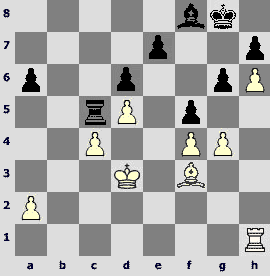
W?
The first problem arises at once. Of course, one wants to choose 31.g5 defending the h6-pawn and locking the Black's bishop. But after 31...¦а5 one will have to part with the a2-pawn (because it is impossible to play 32.¦а1 ¦а3+ 33.ўе2).
The 31...¦а5 threat can be easily refuted by 31.ўс3. Then Black will exchange for g4.
So, what is a right thing to do: either to increase positional achievements at the cost of the pawn or to preserve material equality with slightly smaller positional advantage? Try to make your choice resting upon intuition.
Karpov decided not to sacrifice the pawn and played carefully. I can say in advance that he made a wrong choice from my point of view, though it is hard to prove. First let us see how the struggle went on in the game.
31.ўd3-c3?! f5:g4
32.Ґf3:g4
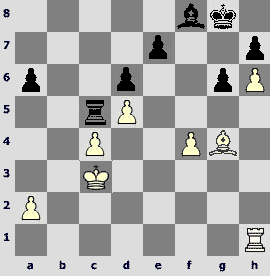
B?
A new question: how should Black defend? One can move the king away from the dangerous zone: 32...ўf7 33.Ґe6+ ўf6, but then the bishop will come for the h7-pawn. An alternative is moderate 32...¦с7 33.Ґе6+ ўh8.
In the majority of cases it is advisable to be active, because in case of a passive defense the opponent feels free to find one or another way of breaking through. But in this situation, according to Karpov, waiting strategy (32...¦с7 33.Ґе6+ ўh8) was possible. 34.f5 (with a beautiful mating threat 35.¦b1! Ґ:h6 36.f6! еf 37.¦b8+) is met by 34...¦b7!. Black wants to play 35...¦b8 and 36...gf, and if 35.Ґf7, then 35...Ґ:h6! 36.¦:h6 ўg7.
It seems that Karpov was not right. White does not have to hurry with the breakthrough on the kingside. It makes sence to trouble the opponent on the queenside first, threatening the a6-pawn (in case of losing it, it becomes unclear how the a-pawn can be queened). Let us play 34.ўb4! (suggested by Ernesto Inarkiev). In case of 34...a5+ there is no use to test whether 35.ў:a5 ¦a7+ 36.ўb5 ¦:a2 37.ўc6 (37.f5) is sufficient for a win – it is easier to choose 35.ўb3 or 35.ўa4 ¦:c4+ 36.ў:a5 ¦:f4 37.a4. And after 34...¦c5 the rook went away from the b-file and the breakthrough wins more convincingly: 35.f5! a5+ 36.ўc3 ¦c7 37.¦b1! Ґ:h6 38.f6! or 35...¦c7 36.¦h2!? followed by 37.ўa5 (immediate 36.ўa5 ¦:c4 is less precise, and 37.¦b1 Ґ:h6 38.f6 does not work because of the intermediate check 38...Ґd2+!).
32. . . . ўg8-f7!
33.Ґg4-e6+ўf7-f6
34.Ґe6-g8 ¦с5-c7!
In the event of 34...Ґ:h6? 35.¦:h6 ўg7 36.¦:h7+ ў:g8 37.¦:е7 the rook ending is lost for Black. But now the e7-pawn is protected and therefore a threat of 35...Ґ:h6 arises.
35.Ґg8:h7 e7-e6!
35...ўf7 36.f5! g5 37.f6! еf 38.Ґf5! ўg8 39.h7+ ўh8 40.¦b1 is hopeless(Karpov).
36.Ґh7-g8 å6:d5
37.h6-h7
37.Ґ:d5? ¦h7 leads to a loss of the h-pawn.
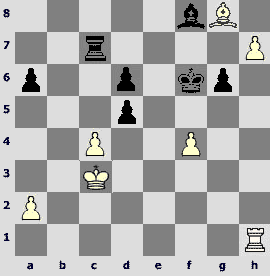
B?
37. . . . Ґf8-g7?
A decisive mistake. It was necessary to play 37...¦:с4+! 38.ўd3. Now 39.h8I? Ґ:h8 40.¦:h8 (in anticipation of 40...ўg7? 41.Ґ:d5 ¦с5 42.¦g8+ ўh7 43.Ґb3) brings nothing because of 40...¦с8! and 41...ўg7. After 39.Ґ:d5 ¦с5 40.Ґе4?! ¦h5! the game also ends in a draw. In case of 40.ўе4! Ґh8 White still preserves winning chances, but a draw is more probable.
38.Ґg8:d5 Ґg7-h8
39.ўc3-d3 ўf6-f5
40.ўd3-e3 ¦c7-e7+
41.ўe3-f3 a6-а5
42.a2-а4 ¦e7-c7
43.Ґd5-e4+ ўf5-f6
44.¦h1-h6 ¦c7-g7
Black loses a rook in the 44...ўg7 45.¦:g6+ ў:h7 46.¦g1+ ўh6 47.¦h1+ ўg7 48.¦h7+ and 49.¦:с7 variations.
45.ўf3-g4
Black resigned.
And now let us study the positional pawn sacrifice, which locks the kingside. This choice seemed most attractive to me, when I studied this game many years ago. Almost all strong chess players whom I asked about this problem were of the same opinion. Now I have to get analytical evidence for that.
31.g5! ¦а5
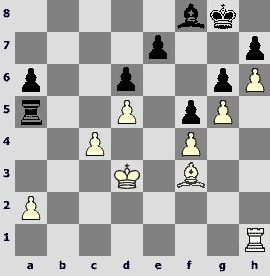
W?
Black has to guess the most accurate continuation right. It looks tempting to occupy the open file immediately: 32.¦b1, but then Black can, for example, exchange the rooks after 32...¦a3+ 33.¦b3. Is such ending with opposite colored bishops won?
There is a nice alternative that ўarpov does not consider in the annotations to the game: 32.Ґd1 ¦:а2 33.Ґb3 with the idea of 34.c5 (let say, in answer to 33...¦f2?). Black has to defend by 33...¦a5 34.ўc3 ўf7.
What would you prefer?
Previously the second decision looked more reliable and convincing to me.
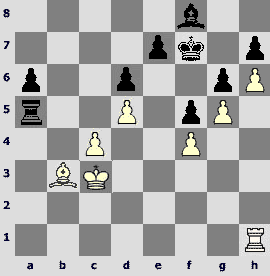
W?
35.ўb4 ¦c5 suggests itself, and now one can decide between 36.¦a1, 36.Ґa4 and 36.¦e1. It was the end of my old analysis, but now I decided to continue it, and soon got convinced that nothing is that simple here.
a) 36.Ґa4 e5! 37.de+ ў:e6 38.¦e1+ (38.Ґe8 d5) 38...ўf7 39.Ґd7 d5! 40.Ґe6+ ўe8 41.Ґ:d5+ ўd7 42.ўb3 Ґd6 does not look very promising.
b) In case of 36.¦a1 one has to take 36...a5+ into consideration. There is a new task: to calculate the bishop ending.
In such situations intuition does not help at all. This is an exercise for training in calculation, the result of the struggle depends on the toss-up in the end of long forced variations, and there is nothing left to do except for calculating them accurately.
36.¦a1 a5+! 37.¦:a5 ¦:a5 38.ў:a5 e6!

W
A draw is obvious after 39.de+ ў:e6 40.c5+ ўd7 41.Ґg8 dc 42.Ґ:h7 Ґd6 43.Ґ:g6 Ґ:f4. A harder thing is to stifle the opponent: 39.ўb6 ed 40.cd Ґe7 41.ўc7. The struggle can go on like that: 41...ўe8 42.Ґa4+ ўf7 43.Ґd7 ўf8 44.Ґe6 ўe8 45.ўc8 Ґf8! 46.ўc7 Ґe7 47.Ґg8 ўf8 48.ўd7! (48.Ґ:h7? ўf7 49.ўd7 Ґ:g5! does not suit) 48...Ґ:g5! 49.fg ў:g8 50.ў:d6 ўf7! 51.ўc7 f4 52.d6 f3 53.d7 f2 54.d8Ј f1Ј, and the queen ending is most likely drawish.
c) An attempt to prevent the e-pawn advance by 36.¦e1 does not reach the aim – Black still plays 36...e5! 37.de+ ўe7 (37...ўe8), and if 38.¦a1, then 38...a5+! 39.¦:a5 ¦:a5 40.ў:a5 ў:e6 41.c5+ ўd7 – we have already seen this draw position in the 36.¦a1 variation. Probably, 38.ўc3 ¦a5 39.c5!? ¦:c5+ 40.ўd4 offers more practical chances to White, but this is not completely clear too.
Let us not put the king on b4, where it gets under the X-rays of the f8-bishop – we will immediately make a prophylactic 35.¦e1! In case of 35...¦c5 36.Ґa4 or 35...ўe8 36.ўb4 ¦c5 37.Ґa4+ the advantages of such move order are obvious, and 35...e5 can be answered by 36.fe! de 37.d6 with decisive advantage.
And still without the e-pawn advance Black has no hopes – he has to test 35...e6! 36.ўb4 (36.¦:e6 Ґe7 does not change a great deal, and in case of 36.de+ the position is the same in the 35.ўb4 ¦c5 36.¦e1 e5 variation) 36...¦c5 37.¦:e6 Ґe7 38.Ґa4 ¦c7 39.ўc3 ¦c8 40.¦e2 (41.¦b2 threatens) 40...¦b8 41.Ґd7 a5, and although Black’s position is still difficult, the result of the game is not obvious.
Let us see now, what happens in case of the other way of attacking: 32.¦b1! In his collection of selected games Karpov gives following variations:
1) 32...¦:а2 33.с5! ¦а3+ 34.ўе2 dс (34...¦с3 35.с6; 34...¦а2+ 35.ўе1 ¦а3 36.с6! ¦:f3 37.¦с1!) 35.d6 еd 36.Ґd5+ ўh8 37.¦b8 with the victory.
2) 32...¦а3+ 33.¦b3 ¦:а2 34.с5 dс 35.d6 е6 36.d7 с4+! 37.ў:с4 (butnot 37.ўс3? ¦с2+! 38.ў:с2 сb+ 39.ў:b3 Ґе7) 37...¦d2 38.¦b7 Ґе7 39.¦b8+ ўf7 40.¦h8 ¦:d7 41.¦:h7+ with considerable advantage.
3) 32...¦а3+ 33.¦b3 ¦:b3+ 34.аb а5 (34...ўf7 35.b4 е5 36.dе+ ў:е6 37.Ґd5+ ўd7 38.Ґg8 ўе8 39.ўd4 Ґе7 40.ўd5 ўf8 41.ўе6) 35.ўс3 ўf7 36.ўb2 е5 37.dе+ ў:е6 38.Ґd5+ ўd7 39.ўа3 Ґе7 40.ўа4 Ґd8 41.Ґg8 ўе8 42.ўb5, and White wins, according to Karpov. It is arguable because of 42...d5! followed by Ґc7, but White can act more accurately: 41.ўb5! ўe7 42.ўc6, and only then Ґg8 (42...a4 43.ba Ґa5 44.ўb5 Ґd2 45.a5 Ґ:f4 46.a6 Ґe3 47.ўc6 is hopeless).
4) 32...ўf7!? 33.¦b2 ¦а3+ 34.¦b3 (34.ўе2 ¦с3) 34...¦:а2 (33.¦b3 ¦:а2 leads to the same position one move quicker) 35.с5 dс 36.d6 с4+ (36...ўе6 37.¦b8; 36...¦а4 37.Ґd5+ е6 38.¦b7+ ўе8 39.Ґс6+ ўd8 40.¦b8x) 37.ў:с4 еd 38.Ґd5+ ўе8 39.¦b8+ ўе7 40.¦b7+ ўd8 41.¦:h7 with White's decisive advantage.
Two first variations seem to be right. Two subsequent ones require specification (in addition to the already done).
Let us consider the endgame with opposite colored bishops and no additional pieces that arises in the third variation (after 32...¦а3+ 33.¦b3 ¦:b3+ 34.аb а5).
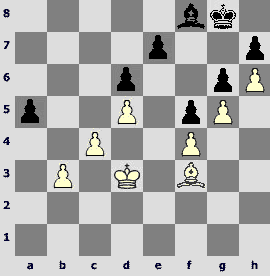
W?
The king's march to the a5-pawn cannot be easily carried out because of the X-ray influence of the Black's bishop on a3 that has to be passed on the way: 35.ўc3 ўf7 36.ўb2 ўe8! (instead of a hasty 36...e5) 37.ўa3 e5!.
Now 38.de d5+ 39.ўa4 dc 40.bc Ґd6 41.Ґh5! (the only chance) 41...Ґ:f4 42.Ґ:g6+ ўe7! (42...hg 43.h7 Ґe5 44.c5 loses) 43.Ґ:h7 Ґ:g5 44.Ґ:f5 Ґ:h6 leads to a drawish position. The consequences of sharper variations 38.ўa4 ef 39.ў:a5 Ґe7 40.b4 Ґ:g5 and 38.fe de+ 39.ўa4 e4 40.Ґd1 Ґe7 (or 40...Ґb4) are difficult to assess.
And still, as grandmaster Alexander Motylev stated, White wins by choosing 35.ўd4! ўf7 36.c5! dc+ 37.ўe5!. 37...ўe8 is followed by 38.ўe6, and if 37...e6, then the easiest way is 38.d6. Here the main idea of White's plan that started with 31.g5! is revealed most clearly. It consists in maximal restriction of the enemy bishop's mobility. Black gets saving chances only when he manages to revive the bishop by e7-e6 or e7-e5.
Let us proceed to the fourth way of defense: 32...ўf7!?.
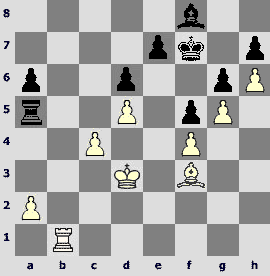
W?
After 33.¦b2?! ¦а3+ 34.¦b3 ¦:а2 35.с5 dс 36.d6 с4+ 37.ў:с4 Black does not play 37...ed?, but 37...ўe6! 38.¦b8 ¦a4+ 39.ўd3 Ґ:h6! 40.de ў:e7 41.¦b7+ ўe6 42.gh ¦:f4 43.ўe3 ¦h4 44.¦:h7 ўf6 with a draw in view of forthcoming disappearing of last White's pawns from the board.
But here there is also a possibility to improve White's play. His advantage is so great that there is no use to go for tense variations with doubtful results. The bishop transfer to b3 (we tested this move earlier too) allows to solve the problem without much effort.
33.Ґd1! ¦:а2 34.¦b8 ¦а3+. 34...¦f2 35.Ґа4 with the threat of 36.Ґd7 or 36.Ґе8+ ўg8 37.Ґd7 is bad. After 34...¦а5 35.Ґb3 with subsequent ўс3-b4 and Ґа4 Black can't move: with white rook on the 8th rank it is already impossible to play e7-e6.
35.Ґb3 а5 36.с5! а4 (the easiest reply to 36...dсis 37.ўс2 а4 38.Ґс4 and 39.d6+) 37.с6!, and the White's pawn queens.
So, we got convinced that 31.g5! provided White with decisive advantage.
Let us come back to the dilemma that we began with. "The reader can make a choice between the text move and the analyzed continuation according to his preferences" (Karpov). I think the conclusion is clear: the future world champion played not in the best way.
I analyzed the second example in my «Endgame manual». I had to considerably correct the annotations for both new American edition and Russian edition that is going to be published.
The endgame analysis presented here is much more extensive than the one in the book (because the framework of the manual limits the author), but it is still not complete: some minor variations are omitted, and only the conclusions are preserved.
Karpov-Kasparov
Moscow 1984/85 (9)
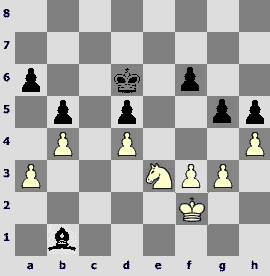
B?
The white's king cannot penetrate into the opponent's camp, thus it should be prepared by using a typical endgame method, «enlarging a beachhead». There are two ways to remove the impeding kingside pawns: g3-g4 or the exchange on g5 with subsequent f3-f4.
But it is Black's turn, and he has to solve the first problem: either make a reasonable waiting move (46...Ґg6 or 46...ўe6 – by the way, which is more precise?), or exchange on h4.
46. . . . g5:h4?!
In home analysis Garry Kasparov decided to change the pawn structure, fairly supposing that after 47.gh Ґg6 White will have no chance to break through (48.ўg3 ўe6 49.¤g2 ўd6 50.¤f4 Ґf7 51.¤d3 Ґe6 52.¤c5 Ґc8, etc.). Alas, neither he nor his trainers saw the following excellent reply, providing the White's king with the way to the opponent's camp.
47.¤e3-g2!! h4:g3+
47...h3 48.¤f4 is useless.
48.ўf2:g3 . . .
Black himself has helped the opponent to get rid of the kingside pawns. Material equality will be reestablished soon (the h5-pawn cannot be protected), and the White's king goes forward freely.
What could happen in case of using other defensive method? This question should be discussed only after we assess several important positions that happened or could happen in the game. And I suggest a small test to those optimists who consider such a long preparation unnecessary.
A possible though not obligatory variation is: 46...Ґg6 47.g4 ўe6 48.ўg3 Ґf7 49.hg fg 50.gh Ґ:h5 51.f4 gf 52.ў:f4.
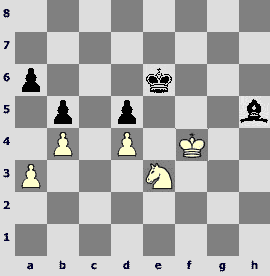
B?
What will you say about the concluding position? You will find this diagram together with the answer in the end of the article.
48. . . . ўd6-e6
Black's king activation is temporary and it cannot prevent the invasion of the opponent's pieces. Grandmaster Mihail Marin (in the perfect book «Learn from the Legends» published in 2004) tested another defense plan: 48...Ґg6 49.¤f4 Ґf7 50.ўh4 ўe7 and proved that it did not improve Black's position.
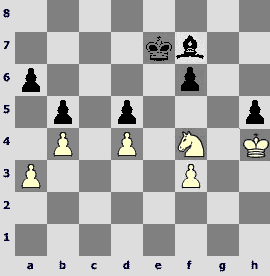
W
51.¤:h5 ўe6 (51...Ґ:h5 52.ў:h5 ўe6 53.ўg6 with subsequent f3-f4-f5 is hopeless) 52.¤g7+ ўe7 53.ўg4 ўd6 (53...Ґg6!? 54.¤h5 and 55.¤f4 lead to what happened in the game) 54.¤h5 Ґe6+ (54...ўe6 55.¤f4+ ўd6 56.ўf5 ўe7 57.¤g6+) 55.ўh4 ўe7 56.¤f4 Ґf7 57.ўg4 (58.ўf5 threatens) 57...Ґg8 58.ўh5 (58.ўf5 Ґh7+) 58...Ґf7+ 59.ўh6 Ґg8 60.ўg7 Ґf7, and now the easiest solution is 61.¤g6+ ўe6 62.¤f8+ ўe7 63.¤h7 f5 64.f4.
49.¤g2-f4+ ўe6-f5
50.¤f4:h5 . . .
The threat of ¤g7-e8-c7 makes the Black's king retreat.
50. . . . ўf5-e6
51.¤h5-f4+ ўe6-d6
52.ўg3-g4 Ґb1-c2
53.ўg4-h5 Ґc2-d1
54.ўh5-g6
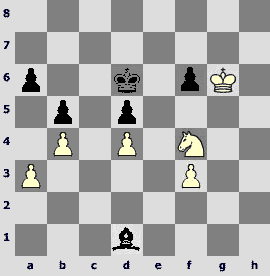
B?
A rather simple question: how should Black continue?
54...Ґ:f3 55.ў:f6 is absolutely hopeless. In such cases gradual forcing back the opponent's king is normally used: the knight moves to f5, after the forced retreat of the king (the pawn ending is lost) the White's monarch stands on е5 or е7, then the knight makes one more check etc.
54. . . . ўd6-e7!
And now there is a question for White. The f6-pawn can be removed in two ways: playing 55.¤:d5+ or 55.¤h5, leaving the d5-pawn alive. What is correct?
Karpov made a wrong decision. As in the previous example, he was let down by excessive greediness (or, speaking more politely, «materialism»). He captured on d5, thus giving Black hope to activate the king through the central square that became vacant – so the position became drawn.
The answer to the question whether 55.¤h5! wins is unobvious (and what do you think about it?), but in any case this continuation is much stronger and more dangerous for Black.
55...Ґ:f3. An attempt of counterattack 55...Ґc2+ 56.ўg7 ўe6 is answered by Marin in the following way: 57.¤:f6 ўf5 (57...Ґb1 58.¤g4 ўf5 59.ўf7 ўf4 60.ўe6 ў:f3 61.¤f6 ўe3 62.ў:d5 with easy victory) 58.ўf7 ўf4 59.ўe6 ўe3 60.ўe5. This variation needs clarification: 58...ўf4? is a poor move – Black escapes by playing 58...Ґd1!. White's play is improved by 58.¤:d5! (instead of 58.ўf7?) 58...Ґb3 59.¤e7+.
56.¤:f6

B?
How should Black defend?
White wins easily by controlling the f6 and the e5 squares, and it happens in the variation 56...ўe6? 57.¤e8 (58.¤c7+ threatens) 57...ўd7 (57...Ґe4+ 58.ўg5 ўd7 59.¤f6+ ўe6 60.¤:e4 de 61.ўf4 ўd5 62.ўe3, and Black is in zugzwang) 58.¤g7 ўe7 (otherwise 59.ўf6) 59.ўf5.
The only defense is 56...Ґe4+! 57.ўg5 Ґd3!

W?
How should White play for a win?
The f6 and e5 squares cannot be controlled by the king now. Taking the central pawn is not very effective again: 58.¤:d5+ ўd6 59.¤c3 (59.¤e3 or 59.¤f4 change nothing) 59...Ґf1! 60.ўf4 Ґg2 61.ўe3 (planning ¤e4-c5) 61...Ґh3! 62.¤e4+ ўd5 63.¤c5 Ґc8 64.ўd3 Ґf5+ 65.ўc3 Ґc8, and Black is out of danger.
I supposed that the variations I had found prove that the position is drawn. But Marin suggested a plan that represent the utmost danger for Black: 58.¤g4! with the idea of ¤e5-c6-b8.
I tried to defend by 58...Ґf1! 59.¤e5 Ґh3, and 60.¤c6+ ўd6 61.¤a5 (61.¤b8?? Ґc8 and 62...ўc7) 61...ўe7! 62.¤b3 ўf7 63.¤c5 Ґc8 is useless now, and winning the d5-pawn by 60.¤g6+ ўf7! 61.¤f4 Ґc8 62.¤:d5 ўe6 leads to the draw already known to us.
But Marin showed the possibility of playing for zugzwang: 60.ўg6! ўe6!? 61.¤c6 ўd6 (61...Ґf5+ 62.ўg5 and 63.¤b8) 62.¤a5 ўe7 63.¤b3 Ґd7 64.¤c5 Ґc8 65.ўg7 (but not 65.ўg5 ўf7) – Black loses the a6-pawn.
However, the game is not over yet – one can temporarily lock the king on g7 by 65...Ґf5 66.¤:a6 Ґd3.
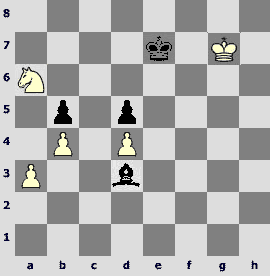
W
It is not easy to bring the king back to his camp: ўh6 is followed by ўf6, and the Black's king moves forward. White continues 67.¤b8 Ґc2 68.¤c6+ ўe6, and after that he has two ways to the aim:
a) 69.ўf8 Ґg6 70.¤a7 Ґd3 71.ўe8 Ґe2 (71...ўf5 72.ўd7 ўe4 73.¤c6) 72.¤c6 ўd6 73.¤e7! (73.¤e5 ўe6 74.ўd8 ўf5 75.¤c6 ўe4 76.ўc7 ўd3! 77.ўb6 ўc4 is weaker) 73...ўe6 74.ўd8 ўd6 (74...Ґf1 75.¤c6) 75.¤f5+ ўe6 76.¤e3 ўd6 77.ўc8 ўc6 78.ўb8, and the king bursts to the b5-pawn;
b) 69.¤e5 ўf5 (69...Ґb1 is followed by 70.ўf8, and in case of passive 69...ўe7 70.¤g4 White places the knight on e3, and then freely brings the king back to the camp and prepares a3-a4, transferring the knight to c3 at the suitable moment) 70.ўf7 ўe4 (70...Ґd1 71.¤c6! ўe4 72.ўe6) 71.¤c6 Ґd1 72.ўe6 (72.ўe7? ўd3 73.ўd6 ўc4 74.ўe5 Ґf3 is inaccurate) 72...Ґh5 73.ўd7! (but not 73.ўd6? Ґe8 74.¤e7 ў:d4 75.¤:d5 ўc4 with a draw) 73...Ґg6 (73...Ґe2 74.ўd6 и 75.ўc5; 73...ўd3 74.a4!) 74.a4! ba 75.b5 a3 76.¤b4, and the b-pawn cannot be stopped.
The complex analysis that I held together with grandmaster Marin proves (if it does not contain considerable mistakes) that minor piece ending with three pawns against three pawns is lost: Black is killed by the presence of his bad bishop, the weakness of the a6-pawn and – last but not least – by absence of counterplay. And after a premature capture on d5 some counterplay appears.
55.¤f4:d5+? ўe7-e6
55...ўd6!? 56.¤c3 (or 56.¤:f6 Ґ:f3) 56...Ґ:f3 57.ў:f6 Ґg2 is more correct, leading the game to the mentioned above drawn position (see the 58.¤:d5+? variation).
56.¤d5-c7+ . . .
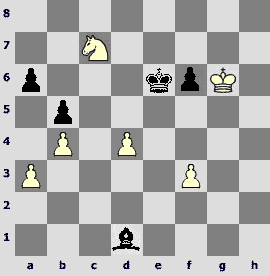
B?
56. . . . ўe6-d7?
An odd decision. Now Black lacks two pawns. 56...ўd6 was stronger. 57.¤:a6 is followed by 57...Ґ:f3 58.ў:f6 ўd5 59.¤c7+ ў:d4 60.¤:b5+ ўc4 with a draw. It seems that Kasparov was embarrassed by 57.¤e8+, and if 57...ўd5, then 58.f4. However, after 57...ўe7 58.¤:f6 Ґ:f3 59.ўf5 ўd6 60.ўf4 Ґg2 61.ўe3 Ґh3 the arisen position is almost the same as one after 55...ўd6.
57.¤c7:a6 Ґd1:f3
58.ўg6:f6 ўd7-d6
59.ўf6-f5 ўd6-d5
60.ўf5-f4 Ґf3-h1
61.ўf4-e3 ўd5-c4
62.¤a6-c5 Ґh1-c6
63.¤c5-d3 Ґc6-g2
63...Ґe8!? 64.¤e5+ ўd5 deserved attention. Even with two extra pawns, the result of the struggle is not obvious – the Black's king is extremely active. He just does not have to hunt for the a3-pawn (White will lock him by putting the king on с3).
64.¤d3-e5+ўc4-c3
64...ўd5!? is also possible.
65.¤e5-g6 ўc3-c4
66.¤g6-e7 . . .
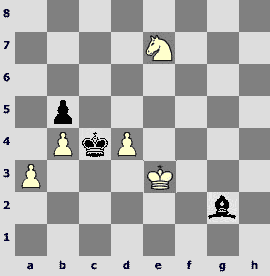
B?
As almost in all analogous positions, the campaign against the a3-pawn does not work: 66...ўb3? 67.d5 ў:a3 68.d6 Ґh3 69.¤d5. The question is where the bishop should retreat.
It will be easier to answer it if we tried to think about White's possible plans. Let us point right now that the pawn ending is drawn: 67.d5 Ґ:d5 68.¤:d5 ў:d5 69.ўd3 ўe5 70.ўc3 ўd5 71.ўb3 (72.a4 threatens) 71...ўc6. Such an endgame is won with the pawn on a2 thanks to the spare tempo. By triangulation White passes the turn to the opponent: 71.ўb2 ўd6 72.ўc2! (zugzwang) 72...ўc6 73.ўb3 (zugzwang again) 73...ўb6 74.ўc3 ўc6 75.ўd4 ўd6 76.a3, or 72...ўd5 73.ўc3 (zugzwang) 73...ўe5 74.ўb3 and 75.a4.
To make progress White has to drive the king back from the active position on the 6th rank and place the knight on one of three squares: c3, e3, f4, depriving the opponent of counterplay. We are not interested now in the question whether it is enough for the victory. We will consider it later, in the annotations to Black's 67th move.
After 66...Ґb7? was played, White solved the aforementioned problem easily. And in case of 66...Ґh1! no obvious ways are seen. Many analysts studied the position closely, but did not manage to find the victory.
67.¤c8 is followed by 67...ўd5 68.ўd3 Ґe4+ 69.ўc3 ўc6 (Timman), and it is hard for the White's knight to free himself. 67.¤f5 is stronger.
As Jonathan Speelman and Jonathan Tisdall mentioned in their book devoted to the first match of Karpov and Kasparov, 67...Ґc6? 68.ўf4! ўb3 (68...ўd5 69.¤e7+) 69.ўe5 ў:a3 70.ўd6 (with tempo – king aims at c5) 70...Ґe4 71.¤g3 loses.
68.¤d6 Ґc6 69.¤c8, и 68.ўf4 ўb3 69.¤e7! ў:a3 70.d5 ў:b4 71.d6 also decides in case of 67...ўc3?.
67...ўd5! is necessary.

W
The advantages of bishop’s position on h1 (in comparison with b7) become obvious immediately – White has no 68.ўd3? because of 68...Ґe4+.
Marin considered 68.ўf4. 68...ўc4? 69.ўe5 ўb3 70.d5 ў:a3 71.¤e7 (71.¤d4 Ґ:d5 72.¤c2+) or 69...Ґc6 70.d5 Ґd7 71.¤d6+ ўb3 72.ўd4 ў:a3 73.ўc5 loses. In case of 68...ўe6 69.¤e3 White’s intermediate aim is achieved: the opponent’s king is locked on his side of the board. To prevent it, Black must play 68...Ґe4! 69.¤d6 Ґd3 (it seems that even 69...Ґg6 or 69...Ґc2 is possible, and after 70.¤:b5 – 70...ўc4) 70.ўe3 Ґf1 71.¤e4 Ґg2 72.¤d2 (if the knight retreats to f6 or c3, then 72...ўc4) 72...Ґh3 73.ўd3 Ґf5+ 74.ўc3 Ґd7, and White got nothing.
In the recently published Jan Timman’s interesting book "Power Chess with Pieces", devoted to struggle of minor pieces, the Dutch grandmaster tried to prove that White wins, and cited a rather strange variation where the pieces retreat towards the lower right corner of the board.
68.¤g3 Ґg2 69.ўf2 Ґh3 70.¤e2 ўc4 71.ўf3 (71.ўe3 Ґg2; 72.¤f4 Ґc8 73.ўe3 Ґb7) 71...Ґf1 72.¤g3 Ґd3 73.ўe3 Ґg6 74.¤e2. In the concluding position Black is really in a bad situation: 75.¤f4 threatens, and then depending on the bishop’s retreat – 76.d5 or 76.ўe4.
The test showed that Black can easily make a draw by 71...ўb3! (instead of 71...Ґf1?) 72.¤f4 Ґf5 73.¤:d5 ў:a3 or 72.ўe4 ў:a3 73.¤f4 Ґc8 74.¤d3 ўb3. Later I saw another elementary refutation of Timman’s plan in Marin’s book: 70...Ґg4!? (instead of 70...ўc4) 71.ўe3 Ґ:e2! 72.ў:e2 ў:d4.
After 68.¤g3 Ґg2 it is more logical to move the king in the other direction: 69.ўd3!?. I have recently discussed this position with subtle expert in endgames Carsten Müller. Here is an amazing variation found by the German grandmaster: 69...Ґf3!? (71...ўc4? 72.¤f6 ўb3 73.ўd2 is bad in case of 69...Ґh3 70.¤h5! Ґf5+ 71.ўe3, and any king retreat is followed by 72.¤f4+, thus, as it can be easily proved, the king has to retreat to d6) 70.¤f1 Ґe4+ 71.ўc3 Ґf3 72.¤e3+.
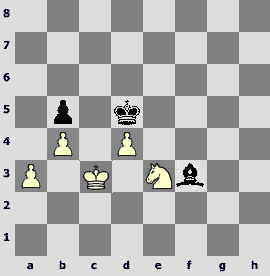
B
We will discuss the king’s retreat to the 6th rank in a note to Black’s next move. Of course, 72...ўe4 suggests itself, but then there is a sudden attack 73.¤c4! I offer the reader to prove that in case of 73...bc? 74.ў:c4 the pawns win against the bishop. One has to play 73...ўd5, and White replies by 74.¤b2 ўc6 75.a4 ba 76.¤:a4.
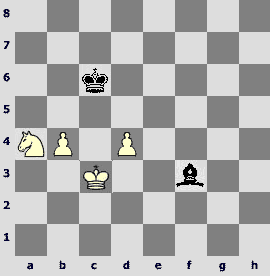
W
In our days the computer solved the majority of positions with less than 6 pieces on the board. And when I asked the computer to assess this position, I got an unpredictable answer: it is a draw! After 76...ўb5 or 76...Ґh5(g4) the White’s pieces do not manage to take the control over b5, c4 and d5 squares. Only in case of erroneous 76...Ґe2? 77.ўd2 and 78.¤c3 weak squares are sealed and White wins.
So: with 66...Ґh1! White can’t even force the king out from active position, and two extra pawns are not enough to win.
66. . . . Ґg2-b7?
67.¤e7-f5 . . .
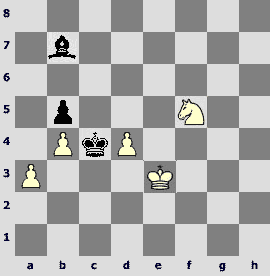
B?
How should Black defend?
67. . . . Ґb7-g2?
It is the line of the least resistance – now the game ends immediately.
68.¤e7-d6+ўc4-b3
69.¤d6:b5 ўb3-a4
70.¤b5-d6
Black resigned.
As Speelman and Tisdall noted, neither 67...ўc3? 68.ўf4 (68.¤d6 Ґc6 69.¤c8 is also strong) 68...ўb3 69.¤e7 ў:a3 70.d5, nor 67...Ґc6? 68.ўf4 ўb3 69.ўe5 ў:a3 70.ўd6 Ґe4 71.¤g3 could save Black.
One must retreat with the king: 67...ўd5! 68.ўd3 ўe6!. 69.¤g3 Ґg2 70.¤e4 Ґf1+ 71.ўe3 ўd5 72.¤c3+ ўc4 is useless – 69.¤e3 suggests itself.
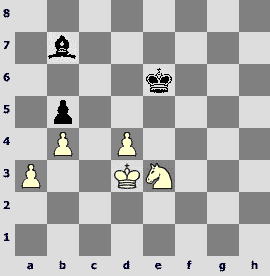
B?
Now it is high time to study the situation with the Black’s king cut off. By the way, which location is best for the White’s knight: e3, c3 or f4? It is not a useless question – the right answer will help both opponents to act in the most accurate way.
It is not hard to guess that c3 is the optimal square. From here knight not only controls d5, but also binds the opponent by attacking the b5-pawn and assists the a3-a4 advance. For example, by putting the knight on c3 and forcing Ґc6, one can move the king to b3 or b2, and play 1.a4 ba+ 2.ўa3 and 3.b5 then.
So, the position is won with the c3-knight – and it means that 69...Ґf3! is necessary, preventing the ¤d1-c3 maneuver. What should White do now?
70.d5+ (counting on 70...Ґ:d5? 71.ўd4 and 72.ўc5) 70...ўe5! brings nothing.
70.ўc3 should be met by 70...ўd6! (otherwise 71.ўb3 with subsequent 72.a4 – one cannot play 71...Ґc6 because of 72.d5+!). Now 71.ўb3 yields nothing: 71...Ґc6 72.d5 Ґe8 73.ўc3 ўe5 with equality. And if 71.a4 ba 72.¤c4+, then 72...ўd5! (but not 72...ўc7? 73.b5) 73.¤b6+ (73.b5 Ґe2 74.b6 ўc6 75.d5+ ўb7 76.d6 ўc6 also leads to a draw) 73...ўc6 74.¤:a4 ўb5 or 74...Ґh5(g4), and the already known drawn position arises.
One has only to test 70.ўd2 with the idea of king’s march to the opponent’s camp. Black king cannot meet him: 70...ўf6? 71.¤d1! and 72.¤c3 (there is no 71...ўd5 answer) are bad. Black has only to wait.
According to Marin, White wins. But it is not so: when the king gets to the 8th rank, the bishop will cut him off the way to the queenside.
Here is one of the positions considered by the Romanian grandmaster.
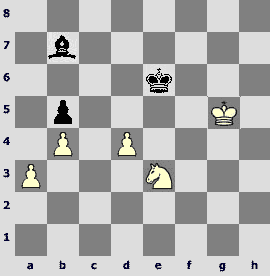
B
Marin continues 1...Ґe4? (depriving the king of the g6-square – but the medicine is worse than the illness!) 2.¤d1! Ґf3 (the pawn ending after 2...ўd5 3.¤c3+ ў:d4 4.¤:e4 ў:e4 5.ўf6 is lost) 3.¤c3 Ґc6 4.ўg6 Ґe8+ 5.ўg7 Ґc6 6.ўf8 ўd6 (6...Ґd7 7.d5+ ўd6 8.¤e4+) 7.d5 Ґd7 8.ўf7 (or 8.¤e4+), winning.
1...Ґf3 2.ўg6 Ґe4+ 3.ўg7 Ґf3 4.ўf8 Ґh5 is correct, and there are no ways to make progress.
Müller checked the situation with the knight on f4.
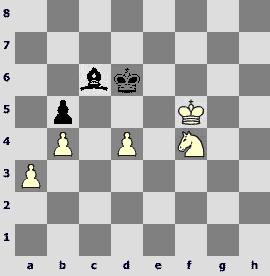
B
Here the bishop does not manage to cut the king off on the h5-e8 diagonal, but one can use another diagonal: h3-c8.
1...Ґf3 2.ўf6 Ґg4 3.ўf7 Ґf5 4.ўe8 Ґd7+! (in case of 4...Ґg4? 5.ўd8 Black gets into zugzwang: 5...Ґf5 6.¤e2! ўd5 – otherwise the decision is 7.¤c3 – 7.¤c3+ ў:d4 8.¤:b5+ ўd3 9.¤d6 or 7...ўc4 8.¤:b5 ў:b5 9.d5 ўb6 10.d6 with the victory) 5.ўd8 Ґg4 6.¤g2 nothing else is seen) 6...Ґh3 7.¤e3 Ґe6 8.d5 (8.¤d1 ўd5 9.¤c3+ ў:d4 10.¤:b5+ ўc4) 8...Ґh3 9.ўe8 Ґd7+ 10.ўf7 Ґh3 11.ўf6 Ґc8 12.ўg5 ўe5 with a draw.
So, even cutting the king off on the 6th rank is not enough for the victory. It seems that the conclusion can be made: Black could have escaped by playing 67...ўd5! 68.ўd3 ўe6! And I thought this way until Carsten Müller showed me the fine way to transfer the knight to the key c3-square.
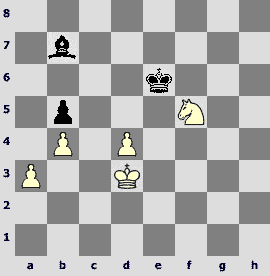
W?
As it happens sometimes, at first the knight has to move in the opposite direction.
24.¤g7+!! ўd7. Retreating to e7 or f7 changes nothing. And if 24...ўd6, then 25.¤e8+ ўd7 (25...ўe7 26.¤c7 Ґc6 27.d5) 26.¤f6+ ўe6 27.¤e4 and 28.¤c3.
25.¤h5 Ґg2. 25...ўd6 is followed not by 26.¤f4? Ґc8! and 27...Ґf5+, but by 26.¤g3(f6)!, then 27.¤e4+ and 28.¤c3. But now 26.¤g3? is wrong because of 26...ўe6! 27.¤e4 Ґf1+ and 28...ўd5.
26.¤f4! Ґf1+ 27.ўe4 ўd6 28.ўe3!
28.d5? Ґc4 29.ўd4 Ґb3(a2) leads to a draw. But now Black suddenly appears in zugzwang. In case of 28...ўc6 29.d5+ ўd6 30.ўd4 Ґc4 (¤h5-f6-e4+ threatened) 31.a4 decides. Bishop has only one available square, but 29...ўd5 30.¤c3+ is useless after 28...Ґc4 29.¤e2, and c4, essential for the king, is busied by the bishop.
Conclusion: the position remained drawn almost till the end. The decisive mistake was done on the 66th move, and by his subsequent move Kasparov missed his chance to complicate the opponent’s task considerably.
Earlier we found out that Karpov had to win in case of rejecting to capture on d5. Nobody managed to find the way to improve Black’s defense after 46...gh?! – so, one has to come back to the very beginning of the endgame and see what could happen after other continuations.
Let us discuss 46...Ґg6 in the beginning.
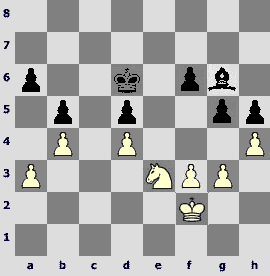
W
Speelman and Tisdall suggested to meet 47.hg fg 48.f4 by 48...Ґe4 49.fg ўe6, but it is an obvious mistake in view of 50.g4! h4 (50...hg 51.ўg3) 51.¤g2.
48...g4 also seems unsuccessful because of 49.f5 Ґh7 50.¤g2 (50.f6? Ґe4), for example: 50...Ґ:f5 51.¤f4 Ґe4 52.¤:h5 ўe6 53.ўe3 ўf5 54.¤g7+ ўg5 55.¤e6+ ўf5 56.¤c7 or 52...ўe7 53.ўe3 Ґg6 54.¤f4 Ґe4 55.¤e2 ўf6 56.ўf4 with the victory. However, Daniel King found that Black nevertheless escapes by rejecting to capture the f5-pawn immediate: 50...ўe7! 51.¤f4 ўf6.
There is no use to show variations, bearing in mind the fact that he also showed an even simpler defense: 48...gf!? 49.gf ўe6. For example: 50.ўg3 Ґf7 51.ўh4 ўf6 52.f5 Ґe8 53.¤:d5+ ў:f5 54.¤c7 Ґf7 55.¤:a6 ўe4.
47.g4!? is far more dangerous for Black. In case of 47...gh 48.gh Ґ:h5 49.¤f5+ ўe6 50.¤:h4 or 47...hg 48.hg gf 49.ў:f3! fg 50.ўg4 the position is almost the same as in the game.
One has to wait: 47...ўe6! 48.ўg3 Ґf7. Now 49.hg fg 50.gh Ґ:h5 51.f4! gf 52.ў:f4 suggests itself.
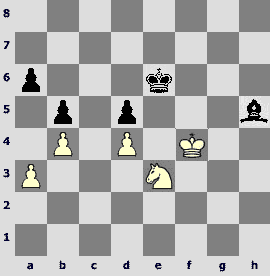
B?
This diagram was suggested as a test-task on the early stage of studying this endgame. In those times it was almost impossible to preview its solution, but now we are well prepared to make the right decision.
Marin continues 52...Ґe2 53.ўg5, etc. – as we already know, White wins gradually by bursting with the knight to the a6-pawn (see the annotation to White’s 54th move).
However, Black’s defense can be improved by a sudden two-pawn sacrifice: 52...ўf6!! 53.¤:d5+ ўe6 54.¤c7+ ўd6 55.¤:a6 – the situation is almost the same as in the game: two extra pawns do not bring victory.
King’s recommendation is also worth being mentioned: 47.ўg2!?, and if 47...gh, then not 48.gh? ўe6 with equality, but 48.g4! hg 49.fg. Anyhow, if Black does not exchange the pawns and plays 47...ўe6, then White still has to carry out g3-g4, and the already considered situation arises.
46...ўe6!? is considered to be Black’s most accurate move.

W
In case of 47.hg fg 48.f4 both 48...gf 49.gf Ґg6 (already mentioned King’s recommendation), and a more reliable 48...g4!? lead to a draw.
Another attempt: 47.g4 hg (there is also 47...Ґg6!? with the same position as in case of 46...Ґg6) 48.hg.
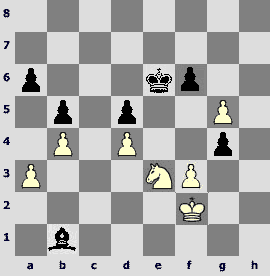
B?
In case of 48...fg?! 49.¤:g4 with subsequent 50.ўg3 and f3-f4 Black’s position is alarming. As John Nunn noted, one has to play 48...gf!, and if 49.ў:f3, then 49...fg 50.ўg4 ўf6! 51.¤:d5+ ўg6 with equality. It is harder to calculate 49.gf Ґe4 50.¤g4 ўf7 51.ўg3 ўe6 52.ўf4 (zugzwang) 52...ўf7 53.ўe5. Black can escape by 53...Ґg6! 54.ў:d5 Ґh5 55.¤f2 ў:f6, for example: 56.ўe4 ўe6 57.¤h3 ўd6 58.ўe3 ўc6 59.¤f4 Ґg4 60.ўf2 ўd6 61.ўg3 ўc6!, or 56.ўd6 ўf5 57.d5 ўf4 58.ўc7 ўe3 59.d6 Ґe8 60.¤g4+ ўd4 (but not 60...ўf4? 61.¤h2 f2 62.d7 Ґ:d7 63.ў:d7) 61.d7 Ґ:d7 62.ў:d7 ўc3 63.ўc6 ўb3 64.ўb6 ў:a3 65.ўa5 ўb3 66.¤f2 ўc3(c4) with a draw (but of course not 66...ўa3?? 67.¤e4!, and Black is in zugzwang: 67...ўb3 68.¤d2+ and 69.¤:f3).
White saves more practical chances for success by rejecting 48.hg and choosing 48.¤:g4!? gh 49.ўg2. 47.ўg2!? also deserves attention, and if 47....gh, then 48.g4!. In both cases White hopes to get the position of the same kind as one in the game. These variations require additional analysis. If one does not manage to find a reliable defense, then Black has waiting strategy left – we saw it when analyzing 46...Ґg6. Most likely Black should be able to achieve a draw, although the way to it is hard and a slightest inaccuracy can cost a lot.
I am far from thinking that the utmost complicated analyses cited in the article are absolutely correct, and I will be glad to hear the remarks, additions etc. The process of approaching the truth (or sometimes unfortunately moving away from it) is often more interesting than the ending result.
